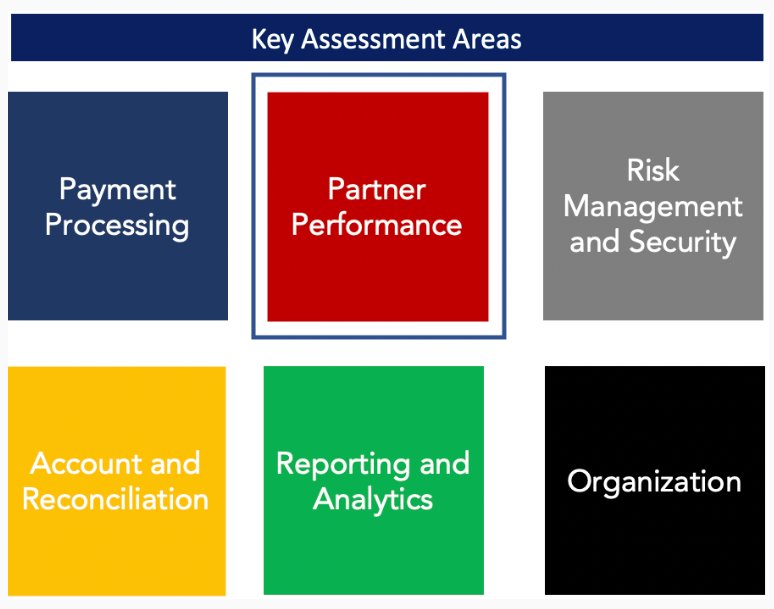Continuing on our theme of Assessing a Merchant’s Payments Operations, in this post let’s focus on the critical aspect of Partner Performance.

The goal here is to gauge if the merchant’s payment providers are good partners. Having the right set of payments processing partners is a critical factor that can take a merchant’s payments operations from good to great.
At this point, competitive pressure has pushed the functional capabilities of many providers close to parity. So, what separates a great partner from a mediocre one?
Let’s break these up into two sets of criteria: those to measure an incumbent provider, and those for evaluation of a new partner.
Incumbent Provider Evaluation
Relationships Matter
Key to the provider’s ongoing value is the quality of the relationship with the provider’s account manager. Ideally, the account manager serves as an extension of the merchant’s own payments team. She is intimately familiar with the merchant’s roadmap, current operational issues, top pain points, and goals. She is also honest and direct about the provider’s current capabilities and future plans. In this role, she can provide strategic insights tailored to requirements, benchmarks to calibrate the merchant’s performance against peers, provide network advocacy, and education to name a few.
It is not hyperbole to say that a good account manager can make or break an existing partnership. Certainly, in our practice, and through feedback on the Merchant Payments Roundtable®, we’ve seen multiple examples where a merchant refuses to renew the incumbent’s contract because of poor account management.
Let’s examine this relationship and role in greater detail:
1. Strategic Assistance and Insights
Auth Optimization. Auth rate optimization is the new acquirer battleground. Providing solutions to increase approval rates, through product offerings and/or proactive optimization strategies, is a true differentiator in the acquiring space. A nuanced understanding of the differences in a merchant’s vertical, type of goods sold (digital goods, vs physical goods), and payments model deployed (subscription, on-demand, card-on-file, trial conversions, freemium, etc.) is key in providing effective advice and solutions to the merchant. Using the champion-challenger model, sophisticated merchants will often measure performance of auth rates over a fixed period of time across their incumbent acquirers in order to route transactions for optimum approval rates.
Business Insights. The degree to which the acquirer is able to interrogate and learn from transaction flow is a differentiator. For example, granular examination will often reveal individual issuers rejecting too many transactions. Increasingly, as acquirers get into the issuing space, they are at a unique vantage point to see the transaction end-to-end and provide actionable insight.
Benchmarks. While not common practice, it is extremely valuable for a merchant to measure its operations compared to its peer group across various metrics such as approval rates, chargeback rates, card type, cost, etc. Acquirers serving merchants in the same vertical can unlock these valuable, anonymized insights.
2. Network Releases, Advocacy, and Impact Assessment
Card networks typically have two compliance releases in a year that may impact merchant/payment acceptor operations. Additionally, advancements in technology and business models have resulted in the creation of several new operational constructs such as marketplaces and PayFacs, each model requiring its own set of evolving rules, network tokenization, new chargeback management models, and more.
A good payment provider helps the merchant understand and respond to the implications of these semi-annual updates, and, where possible, serves as an advocate by serving as the “voice of the merchant” with the networks. In this role, the acquirer can influence the creation of new network rules, and occasionally postpone compliance deadlines when changes could, for example, create a significant burden on merchants’ resources. A provider should help clarify the financial or operational impact of network updates.
3. Education and Relevant Trends
Merchant payments leadership is, of course, responsible for knowing what’s happening in their industry and its impact on their own operations. Building a robust roadmap while balancing the daily demands of managing operations is a challenge. A proactive payments provider should bring the latest trends and developments in the industry and their implications to the merchant.
Ideally, merchants should be able to look to their acquirers to help them unpack new developments and leverage new solutions. Consider the delay in the network’s spring release because of the coronavirus. This delay, shifts in fraud trends, changes to chargeback response times, will all impact merchants. Timely dissemination of changes and evaluation of their implications to the merchant is critical. Data-driven insights, such as changes in contactless usage or shifts in online commerce across a provider’s portfolio, might help merchants adjust their priorities and business models.
4. Relationship Management
The value a good account manager brings to a relationship is unquestionable. Strong relationship management practices strengthen ongoing operational activities such as chargeback management, settlement rejects, data violations, etc.. Managing these operational aspects can make mundane work delightful, efficient, and reveal opportunities for improvement.
The acquirer’s Quarterly Business Review (QBR) is a powerful tool when used well. Instead of a checkpoint on the calendar, a good QBR is the vehicle to exchange roadmaps, brainstorm “over the horizon” initiatives, and review and refine operational processes. This adds value well beyond providing a pulse check on the merchant’s KPIs.
Strong relationship management practices recognize the increased demands of a growing business. They deliver proactive recommendations to address the merchant’s evolving operational, product and strategic fronts.
The New Partner
We’ve written about how an acquirer can keep a customer. When choosing a new provider, at a high level, the assessment criteria cover three broad areas:
- Available functionality
- Operational construct
- Commercial terms
Of course, vetting a provider’s track record through reference checks with existing customers generates valuable insights.
This kind of evaluation is, itself, a lengthy process that is best conducted with rigor and a deep understanding of acquirer capabilities, and pricing strategies, amongst other things. At Glenbrook, we often assist merchants in choosing new payment providers through an RFP (Request for Proposal) process.
Do you have a partner that you’re particularly delighted with? Not so much? Looking for new providers to partner with? We’d love to hear your experience. Also, drop us a line if you would like to discuss how your organization could benefit from Glenbrook’s Merchant Payments Assessment.


